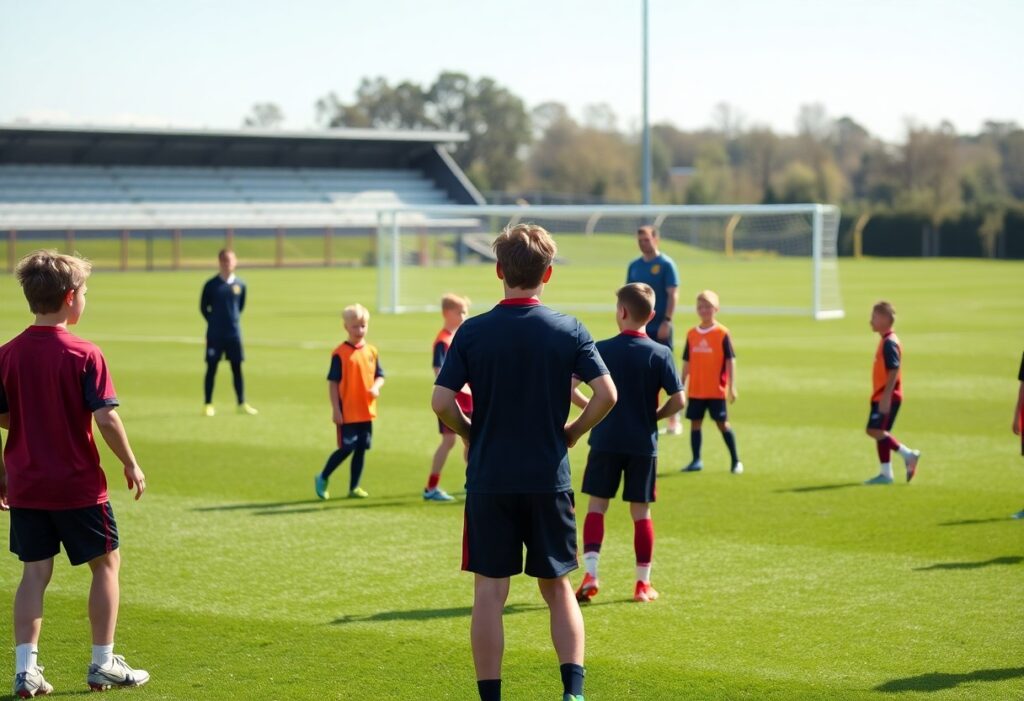
Premier League youth academies are at the forefront of developing young talent, creating an environment where aspiring footballers can thrive. These academies not only focus on technical skills but also emphasize mental resilience, teamwork, and personal growth, ensuring that players are equipped for the challenges of professional football. With access to world-class coaching, facilities, and competitive matches, these programs are instrumental in shaping the next generation of stars who may one day light up the pitch in the Premier League.
Types of Youth Academies
Different models of youth academies play a significant role in shaping future talent. Professional football clubs often have structured programs designed to identify and nurture young players, while independent football academies focus on skill development outside traditional club environments. The choice of academy can influence a player’s career trajectory greatly. Recognizing the various pathways available is necessary for aspiring footballers.
| Type of Academy | Description |
|---|---|
| Professional Football Clubs | Affiliated with clubs in leagues, they offer structured, resource-rich programs. |
| Independent Football Academies | Private entities focused on skill development and player exposure. |
| Academy Partnerships | Collaborations between clubs and educational institutions for holistic development. |
| Community-based Academies | Focuses on local youth engagement and skills training. |
| International Academies | Programs aiming to identify global talent, often involving travel for exposure. |
Professional Football Clubs
Professional football clubs provide comprehensive training and competitive experiences for youth players. These academies often serve as feeder systems for the senior teams, allowing young talents to transition smoothly into professional football. Clubs like Manchester United and Chelsea have invested heavily in their youth setups, ensuring state-of-the-art facilities and experienced coaching staff to maximize player potential.
Independent Football Academies
Unlike professional clubs, independent football academies operate outside the club system, offering specialized training and development programs. These academies often cater to various skill levels and age groups, focusing on individual player growth and exposure to opportunities that may not be available within traditional club environments.
Independent football academies have gained popularity for their tailored approach to player development. Many, like the Clarity Soccer Academy, emphasize creative play and football intelligence in their curriculums. By fostering an environment that prioritizes personalized coaching and technical skills, these academies have produced players capable of competing at high levels. They often collaborate with professional clubs for player trials, effectively bridging the gap between grassroots football and professional leagues.
Key Factors in Youth Development
Several key factors contribute to successful youth development in Premier League academies. These include coaching quality, player scouting, and a focus on mental resilience. Each element plays an imperative role in molding young talent into professional athletes. Emphasizing holistic training aids players in realizing their potential both on and off the pitch. Perceiving the long-term benefits of this approach sets Premier League academies apart from others.
Coaching Quality
Exceptional coaching quality is instrumental in nurturing young footballers. Top-tier academies employ experienced coaches who prioritize both technical skills and personal development, ensuring players receive tailored guidance. These coaches utilize innovative training methodologies, emphasizing fundamentals while fostering creativity. A significant number of academy players have attributed their progress to the positive influence of their coaches who continuously push them to excel.
Player Scouting and Recruitment
Effective player scouting and recruitment are vital to establishing a strong youth pipeline. Premier League academies employ dedicated scouts who analyze talent from various backgrounds and regions, ranging from local clubs to international competitions. By casting a wide net, they identify promising prospects as early as age 8 or 9, allowing for early development in a structured environment.
Scouts focus on a blend of attributes, including technical ability, physicality, and the player’s attitude in matches. For instance, clubs like Manchester United and Chelsea are known for their rigorous identification processes that include extensive network evaluations. This commitment to thorough scouting helps academies discover not just the most talented players but those who exhibit the potential for growth. The comprehensive approach enables clubs to invest in young talent that can flourish within their systems, solidifying their future success.
Tips for Aspiring Young Players
- Commitment to training is fundamental.
- Develop a strong work ethic.
- Focus on skill development and maintain curiosity.
- Embrace teamwork and communication on the field.
- Seek feedback from coaches and peers to improve.
Perceiving the path to success requires dedication and a willingness to learn.
Training and Practice Regimen
A structured training routine is crucial for young players. Engage in regular practice sessions that focus on both technical skills and physical conditioning. Incorporating drills that enhance agility, ball control, and tactical awareness can lead to significant improvements. Consistency in executing these drills is vital to developing the necessary expertise and boosting confidence on the pitch.
Mental and Emotional Resilience
Sporting challenges demand solid mental strength and emotional intelligence. Young players must learn to handle pressure, cope with setbacks, and maintain focus amid competition. This resilience is often the difference between reaching one’s potential and falling short, as strong players efficiently manage their emotions both during training and matches.
Mental and emotional resilience is built through experiences and self-reflection. Athletes face numerous pressures, from performance expectations to peer comparisons. Developing coping mechanisms, such as visualization techniques and mindfulness, can enhance focus and reduce anxiety. Additionally, support from coaches and family plays a significant role in fostering a positive mindset, further instilling the belief that resilience is just as crucial as physical ability in achieving success.
Step-by-Step Journey through an Academy
| Stage | Description |
|---|---|
| Entry and Selection Process | Young players are scouted through local clubs and schools; talent identification camps are held to assess potential. |
| Training and Development | Players undergo rigorous training focusing on technical skills, tactical understanding, and physical fitness. |
| Progression to Professional Levels | Successful academy players may secure placements in senior teams or be sent on loan to gain experience. |
Entry and Selection Process
The entry and selection process begins with scouting at grassroots levels, where potential talent is identified often through local clubs, schools, and organized trials. Only a select number of players are invited to join an academy, typically through assessment camps where their skills, attitude, and potential are evaluated by experienced coaches.
Progression to Professional Levels
Once players demonstrate continued growth and skill enhancement, they have the opportunity to enter the professional levels. Success at the academy level often leads to trials with senior teams. Here, young talents may either secure a spot on the first team or go on loan to lower division clubs, gaining valuable match experience to hone their skills further. Coaches closely monitor these transitions to facilitate development aligned with club strategies.
The pathway from academy to professional levels varies; while some players may flourish quickly, others take years of hard work and persistence. A notable example is Phil Foden of Manchester City, who demonstrated consistent dedication, which eventually earned him first-team appearances and a role in winning multiple titles. This journey often requires a strong support system, including mentoring from coaches and professionals, and a commitment to improvement.
Pros and Cons of Joining an Academy
| Pros | Cons |
|---|---|
| Access to elite coaching | High-pressure environment |
| Training facilities and resources | Reduced family time |
| Competitive match opportunities | Possibility of burnout |
| Exposure to scouts | Limited guarantees for a professional career |
| Development of soft skills | Potential for injury |
| Network building | High expectations and pressure |
| Structured progression pathways | Risk of early specialization |
| Cultural integration within the sport | Competitive atmosphere leading to exclusion |
| Opportunities for scholarships | Financial strain on families |
| Enhanced visibility and recognition | Exposure to negative influences |
Advantages for Player Development
Joining an academy allows young players to benefit from elite coaching and structured training regimens that enhance both technical and tactical skills. The access to advanced facilities facilitates accelerated learning, while competitive matches increase game intelligence and situational awareness. Additionally, players gain exposure to a network of scouts, significantly increasing their chances of a professional contract.
Potential Challenges and Drawbacks
While the potential rewards are significant, aspiring players face considerable challenges within academies. High-pressure environments can lead to stress and anxiety, while intense training schedules may reduce family time and social interactions, impacting emotional well-being. Furthermore, the lack of guarantees for a professional career can create disillusionment, and early specialization might hinder overall athletic development.
The reality is that the pursuit of a career in professional football comes with its share of difficulties. Young players may experience strong pressure to perform, which can lead to stress and dissatisfaction. The demanding schedules often require sacrifices, including reduced time with family and friends, which can result in feelings of isolation. As players focus on honing their skills, there is also a risk of burnout, as they may struggle to balance the rigorous training with personal interests and academic obligations. Moreover, the fierce competition within academies means that not every talented athlete will secure a professional contract, highlighting the harsh reality of the footballing landscape.
The Role of Parents in Youth Football
Parents play an integral part in the development of young footballers, influencing their journey through support, guidance, and involvement in their training. Being actively engaged creates a positive environment in which children can thrive. The balance between encouragement and understanding the challenges of competitive football is vital for a child’s growth, both on and off the pitch.
Support and Encouragement
Providing emotional support during setbacks and celebrating achievements fosters resilience in young athletes. Parents’ involvement, whether by attending matches or simply offering words of confidence, significantly boosts their child’s morale and passion for the game. Consistent encouragement helps develop a strong mindset imperative for navigating the pressures of youth football.
Managing Expectations
Setting realistic expectations is important for both parents and players. When families align on goals, they help mitigate the pressures of competition and reduce anxiety. Understanding that success is not solely defined by immediate results allows young players to focus on their personal development rather than external benchmarks.
Many parents tend to project their aspirations onto their children, which can create overwhelming pressure. Acknowledging that each player’s journey is unique is critical; not all young athletes will become stars. Instead, fostering a culture of growth and enjoyment can be more beneficial in cultivating a lifelong love for football, regardless of the outcome. Parental understanding and patience are imperative in promoting a healthy relationship between the player and the sport, ultimately encouraging sustainable development and happiness.
Summing up
Drawing together the diverse elements of Premier League youth academies reveals a comprehensive approach to developing future football talents. These academies prioritize technical skills, tactical understanding, and personal growth, grooming young players for the demands of professional football. By integrating rigorous training, mentorship, and competitive opportunities, clubs not only enhance individual capabilities but also foster teamwork and discipline. As a result, the Premier League youth academies stand as pivotal institutions in shaping the next generation of football stars, ensuring a sustained influx of talent to the top levels of the sport.
FAQ
Q: What is the primary role of youth academies in the Premier League?
A: The primary role of youth academies in the Premier League is to develop young athletes by providing them with training, education, and resources to enhance their football skills and knowledge. This prepares them for potential careers as professional players, ensuring that clubs have a continuous pipeline of talent.
Q: How do Premier League youth academies identify promising young talent?
A: Premier League youth academies identify promising young talent through extensive scouting networks, which evaluate players in local clubs, schools, and grassroots football. They also host trials and partner with community organizations to discover and recruit players with high potential.
Q: What training methods do youth academies use to develop players?
A: Youth academies employ a variety of training methods, including technical skill drills, tactical simulations, and strength and conditioning programs. Coaches focus on both physical development and mental resilience, ensuring players are well-rounded and prepared for the demands of professional football.


